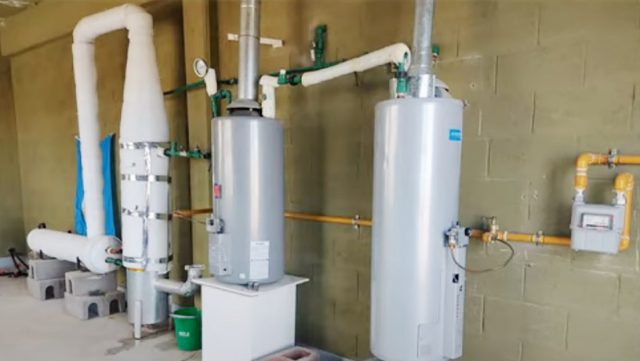In the southern city of Caleta Olivia, province of Santa Cruz (Argentina), they have little drinking water. The supply is rationalized, and there are neighbors who can wait two or three days for each distribution in the zonal network. They know that when the precious liquid runs out, they must fill the storage tanks in their homes, to use it responsibly and austerely.
That coastal area, like Comodoro Rivadavia, increased its population exponentially as the oil boom expanded in the Patagonia. To such an extent that the water resource is no longer enough to be used freely. Worse yet, the extensive 1960s aqueduct that connects to distant Lake Musters some 160 miles away is often in disrepair. «The town has been almost a month without distribution of drinking water», reviews a local citizen, remembering the resounding protests of 2014 due to an extensive interruption of the water distribution service. The conflict persisted, to a lesser extent, until today.
With this framework, researchers from the National University of Austral Patagonia (UNPA) began looking for alternatives in 2016, and looked towards the Atlantic: «Desalination seemed like a possible solution», scientist Adrián Brunini tells RT. Under his leadership, the team from the National Scientific and Technical Research Council (CONICET) has just built a system to make seawater drinkable, «an inexhaustible resource». The mechanism arrives with the hope of solving the problem of scarcity and they affirm that it does not generate an environmental impact.
How does it work?
«We turned to a technology that copies the natural cycle of water, which is called dehumidification», explains Brunini. It is a device where sea water is placed and heated «to a moderate temperature», between 70 and 90 degrees. That is, «as if it were used to drink mate (Argentinian popular drink)», said Brunini.
Once it is hot, the liquid is allowed to ‘run’ in a similar way as if it is coming out of a shower, and it must be put in contact with an air current. Thus, moist air is obtained, which absorbs only water, without the salt. That gaseous result must be transformed back into a liquid state, inside a device called a condenser, and that’s it, «ultra pure water» is achieved. Thus, for every liter of seawater, 10% can be obtained for consumption, and the rest returns to the ocean.
The interviewee clarifies that this procedure is different from distillation. Brunini points out that, «it is not that you boil the water, you generate steam and then you condense that steam. That is very expensive from an energy point of view». The great environmental dilemma to achieve potabilization is how seawater is heated. For practical purposes, the heat can be obtained from gas or other fossil fuels, but this «generates greenhouse gases, which contribute to climate change». So, thinking of tomorrow, another source of energy is needed.
A variant could be the sun, but productivity would be too limited. «You cannot heat large volumes of water, you would need to invest in huge solar connectors», ruled out the expert. Thus, the idea of using boilers that work with hydrogen began to gain strength.
«Nature’s most energetic fuel»
Like gas, this element produces a flame when mixed with oxygen. Its main advantage is that it does not harm the environment, because combustion generates water vapour. In addition, «it is the most energetic fuel that exists in nature» – remarks the academic – since «with a small volume, a lot of heat is generated». Indeed, to produce a liter of drinking water with this system, only 18 grams of hydrogen are needed, which is a low quantity.
The great disadvantage is that there are still no burners on the market that work with this energy source. These are instruments that follow the same logic as a typical kitchen stove, and they are the ones needed for this process. «The problem with hydrogen is safety, the flame is produced very quickly, with a very high combustion speed. Like naphtha, it is much more explosive than natural gas», details Brunini.
And he adds that, «just now that hydrogen is positioned as the fuel of the future, some companies in Europe and the US have started to develop burners». Meanwhile, Brunini and his team, together with engineers from the city of La Plata, got down to work to design their own. «We think that this year we will be able to build it», he told RT.
Can it be produced on a large scale in Argentina?
«Everything depends on the costs of hydrogen generation, but it can be done», answers the expert from CONICET. «There’s no harm in extending it to whatever scale you want», he adds. Currently, the project only has small laboratory equipment that can provide 10 liters of drinking water per hour. To think of something bigger that can respond to higher demands, more prominent teams would be needed.
The key – Brunini believes – would be «to reduce the costs of hydrogen production, which is still expensive». Likewise, «it is thought that in the next five years the costs will be reduced by half, then there would be no problem in scaling the equipment».
In any case, innovation is already attracting attention and the liaison offices of CONICET and the southern university are making contacts with companies and cooperatives that may require this equipment. «It has applications that go beyond desalination of seawater, it is possible to do it with other waters, such as industrial waste», indicates Brunini.
A clear example is the oil sector: “When oil is extracted in the Gulf of San Jorge [one of the largest sources of crude oil in the country], 10% is oil and the rest is ultra-salty water, much more than the sea. There is no technology capable of desalinating that water, but ours can». In this regard, there are already advanced conversations with the Municipality of Cañadón Seco.
This would be done to preserve the supply of the network and that it is not used in industry, which could be supplied with its own desalinated water, for cleaning equipment or other tasks. Brunini assures even more and says that, if it weren’t for social fear, one could even drink it. «Imagine if I told you ‘have a glass of this petroleum water’, I don’t think you would want to, even if it is pure, because there is a cultural issue».
Meanwhile, the residents of Caleta Olivia await a solution for the lack of supply of drinking water. Recently, a reverse osmosis plant has been installed, which makes seawater drinkable using the filtering method and has improved the situation a bit, but it only supplies a small portion of the total demand. This type of technology, one of the best known in the sector, has several counterpoints. First of all, Brunini warns that the chemicals used to treat liquids return to the sea. At the same time, the process demands a large amount of conventional energy, because the water must pass through the filters at very high pressure.
For this reason, the researchers maintain that their invention has several comparative virtues, in addition to using «100% renewable energy» and not harming the planet. For Brunini, another quality is the «low maintenance», as they are «very robust and stable» machines. Likewise, “all the equipment is produced locally, it is simple, and the metallurgical workshops that they build for these machines are very viable”. The data is not minor for a country with serious economic problems, where the local currency is constantly devalued against the dollar.
Thus, in the last few hours, the firm Agua y Saneamientos Argentinos (AySA) requested a meeting with the CONICET academics. However, beyond the enthusiasm, there are still no political signs of wanting to replicate this development in the different territories to guarantee drinking water. «At the moment, none of the coastal cities has contacted us to install a plant of this nature», comments the scientist. And in Caleta Olivia, the water resource continues to be used, drop by drop.



